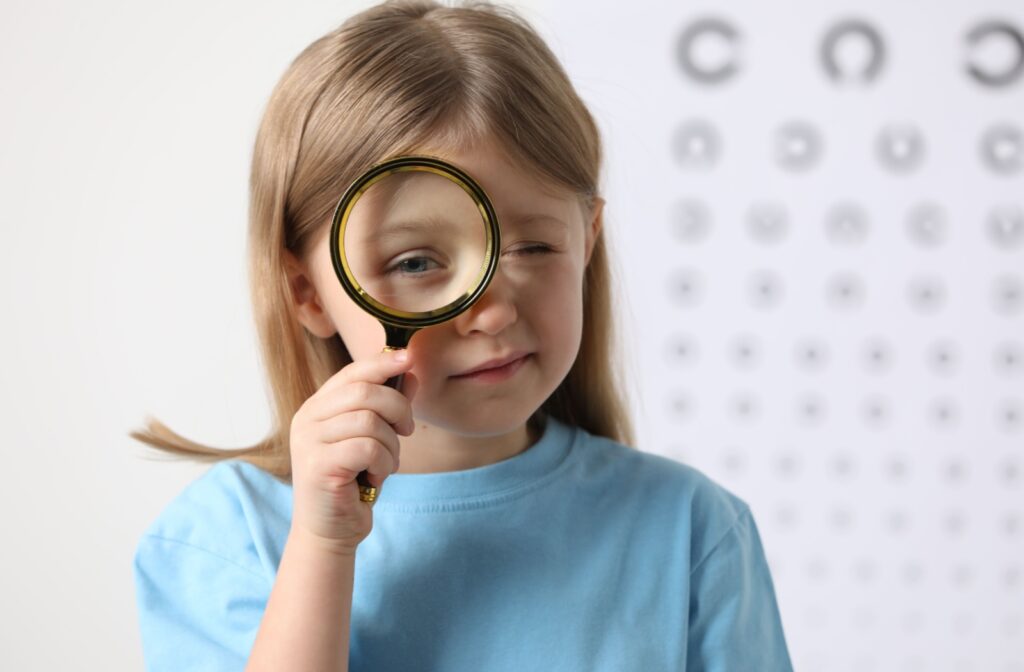If you or your child has myopia (also known as nearsightedness), you may be wondering how this condition changes over time. Will it stay the same? Or does myopia tend to worsen with age? The short answer: it depends on your age, eye health, and whether any control methods are in place.
Myopia is one of the most common vision conditions worldwide, especially in children. It makes it difficult to see objects at a distance, while near vision often remains clear. For many, it starts early in life—and without proper care, it can progress and impact long-term eye health.
Understanding how and why myopia changes with age can help you make informed choices for your vision or your child’s. Let’s break it down.
What Is Myopia?
Myopia occurs when the eye grows too long from front to back or the cornea is too curved. Instead of focusing light directly on the retina (the light-sensitive tissue at the back of your eye), the eye focuses light in front of the retina. The result? Distant objects look blurry, while close-up ones remain clear.
This refractive error often shows up during childhood, typically between ages 6 and 14. It can worsen rapidly during growth spurts and then usually levels off in early adulthood, around age 20. But this isn’t always the case.
Does Myopia Worsen Over Time?
For most people, yes—myopia tends to worsen through the growing years. Here’s what typically happens by age:
Childhood to Teenage Years:
This is when most eye growth occurs. Myopia often develops or progresses rapidly during these years, particularly during early adolescence. This is because the eye is still elongating, and environmental factors (like time spent indoors or on screens) can contribute.
Early Adulthood (20s):
In many cases, the progression of myopia slows or stops once the eyes stop growing. However, this isn’t a guarantee. Some people do experience continued changes, especially if they spend long hours doing close-up work or if they have high myopia.
Middle Age & Beyond:
In most cases, myopia stabilizes during adulthood, but other vision changes can occur. Presbyopia (age-related farsightedness) begins around age 40, often requiring separate vision correction. High myopia can also increase the risk of retinal issues, glaucoma, and cataracts later in life.
What Causes Myopia?
The exact causes of myopia are still being studied, but several factors are known to contribute:
- Genetics: If one or both parents have myopia, there’s a higher chance their child will develop it.
- Lifestyle: Spending excessive time on close-up tasks like reading or screen use, especially indoors, is associated with a higher risk.
- Lack of outdoor time: Research shows that kids who spend at least 2 hours a day outdoors are less likely to develop myopia.

Why Myopia Management Matters
While glasses and contact lenses can correct blurry vision, they don’t stop myopia from getting worse. That’s where myopia management comes in. These strategies can help slow the progression of myopia in children and reduce their risk of serious eye conditions later in life.
Some proven myopia control methods include:
1. Atropine Eye Drops
These prescription drops are used nightly to relax the eye’s focusing mechanism, helping to reduce the rate of eye elongation. They’re safe in low concentrations and commonly used alongside other treatments.
2. MiSight® Contact Lenses
These FDA-approved soft contact lenses are designed specifically for myopia control in children. They provide clear vision while sending signals to the retina that help slow eye growth. Worn during the day and discarded at night, they’re easy for kids to use.
3. Orthokeratology (Ortho-K)
Ortho-K lenses are worn overnight to temporarily reshape the cornea. During the day, users can enjoy clear vision without glasses or contacts. Ortho-K also helps slow the progression of myopia, making it a convenient, non-invasive option.
FAQs About Myopia & Aging
Can myopia go away on its own?
No. Myopia doesn’t resolve on its own. Once the eye has elongated, that structural change remains. However, myopia progression can be slowed with proper treatment.
Is it normal for adult myopia to worsen?
Mild changes can occur in adulthood, especially due to lifestyle factors like extended screen time. Significant changes should be evaluated by an optometrist to rule out other issues.
Is high myopia dangerous?
High myopia (typically defined as -6.00 diopters or more) increases the risk of serious eye complications, including retinal detachment, glaucoma, and myopic macular degeneration. That’s why slowing myopia early is so important.
Can adults benefit from myopia management?
Myopia control methods are most effective in children, as their eyes are still developing. However, adults with progressive or high myopia should still have regular eye exams to monitor their eye health.
How often should myopic children have eye exams?
Children with myopia should typically have comprehensive eye exams every 6–12 months, depending on their treatment plan and rate of progression.
Keeping Myopia in Check
While myopia is incredibly common, especially among kids, it doesn’t have to take control of your or your child’s vision. Understanding how it changes with age—and how to manage it—can make all the difference.
If you’ve noticed vision changes, blurry distance vision, or your child is struggling to see the board at school, don’t wait to take action. At Eclectic Eyewear in Austin, we’re here to help you understand your options and keep your eyes healthy at every age. Book an eye exam with us today to get started on a plan that’s right for you or your child.


